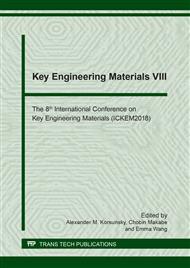[1]
M. A. Kadivar, J. Akbari, R. Yousefi, A. Rahi, and M. G. Nick, Investigating the effects of vibration method on ultrasonic-assisted drilling of Al/SiCp metal matrix composites,, Robot. Comput. Integr. Manuf., vol. 30, no. 3, p.344–350, (2014).
DOI: 10.1016/j.rcim.2013.10.001
Google Scholar
[2]
C. Zhang, W. Cong, P. Feng, and Z. Pei, Rotary ultrasonic machining of optical K9 glass using compressed air as coolant: A feasibility study,, Proc. Inst. Mech. Eng. Part B J. Eng. Manuf., vol. 228, no. 4, p.504–514, (2013).
DOI: 10.1177/0954405413506195
Google Scholar
[3]
Y. Ahmed, W. L. Cong, M. R. Stanco, Z. G. Xu, Z. J. Pei, C. Treadwell, Y. L. Zhu, and Z. C. Li, Rotary Ultrasonic Machining of Alumina Dental Ceramics: A Preliminary Experimental Study on Surface and Subsurface Damages,, J. Manuf. Sci. Eng., vol. 134, no. 6, p.64501, (2012).
DOI: 10.1115/1.4007711
Google Scholar
[4]
R. Zemann, L. Kain, and F. Bleicher, Vibration assisted machining of carbon fibre reinforced polymers,, Procedia Eng., vol. 69, p.536–543, (2014).
DOI: 10.1016/j.proeng.2014.03.023
Google Scholar
[5]
K. Ding, Y. Fu, H. Su, Y. Chen, X. Yu, and G. Ding, Experimental studies on drilling tool load and machining quality of C/SiC composites in rotary ultrasonic machining,, J. Mater. Process. Technol., vol. 214, no. 12, p.2900–2907, (2014).
DOI: 10.1016/j.jmatprotec.2014.06.015
Google Scholar
[6]
F. Makhdum, V. A. Phadnis, A. Roy, and V. V. Silberschmidt, Effect of ultrasonically-assisted drilling on carbon-fibre-reinforced plastics,, J. Sound Vib., vol. 333, no. 23, p.5939–5952, (2014).
DOI: 10.1016/j.jsv.2014.05.042
Google Scholar
[7]
J. Wu, W. Cong, R. E. Williams, and Z. J. Pei, Dynamic Process Modeling for Rotary Ultrasonic Machining of Alumina,, J. Manuf. Sci. Eng., vol. 133, no. 4, p.41012, (2011).
DOI: 10.1115/1.4004688
Google Scholar
[8]
J. Wang, P. Feng, J. Zhang, C. Zhang, and Z. Pei, Modeling the dependency of edge chipping size on the material properties and cutting force for rotary ultrasonic drilling of brittle materials,, Int. J. Mach. Tools Manuf., vol. 101, p.18–27, (2016).
DOI: 10.1016/j.ijmachtools.2015.10.005
Google Scholar
[9]
D. Lv, Y. Zhang, and Y. Peng, High-frequency vibration effects on hole entrance chipping in rotary ultrasonic drilling of BK7 glass,, Ultrasonics, vol. 72, p.47–56, (2016).
DOI: 10.1016/j.ultras.2016.07.011
Google Scholar
[10]
J. Wang, H. Zha, P. Feng, and J. Zhang, On the mechanism of edge chipping reduction in rotary ultrasonic drilling: A novel experimental method,, Precis. Eng., vol. 44, p.231–235, (2015).
DOI: 10.1016/j.precisioneng.2015.12.008
Google Scholar
[11]
J. Wang, P. Feng, and J. Zhang, Reduction of edge chipping in rotary ultrasonic machining by using step drill: a feasibility study,, Int. J. Adv. Manuf. Technol., p.1–11, (2016).
DOI: 10.1007/s00170-016-8655-8
Google Scholar


